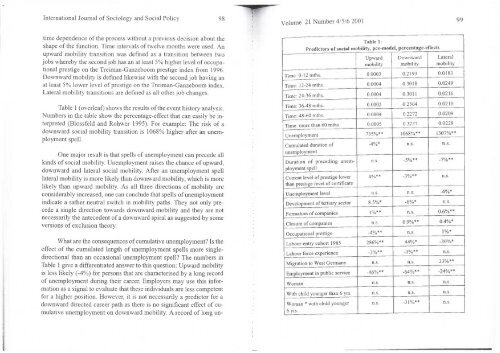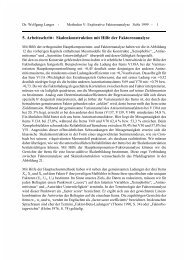EXPLAINING SOCIAL EXCLUSION - Institut für Soziologie
EXPLAINING SOCIAL EXCLUSION - Institut für Soziologie
EXPLAINING SOCIAL EXCLUSION - Institut für Soziologie
You also want an ePaper? Increase the reach of your titles
YUMPU automatically turns print PDFs into web optimized ePapers that Google loves.
International Journal of Sociology and Social Policy 98<br />
time dependence of the process without a previous decision about the<br />
shape of the function. Time intervals of twelve months were used. An<br />
upward mobility transition was defmed äs a transition between two<br />
Jobs whereby the second Job has an at least 5% higher level of occupational<br />
prestige on the Treiman-Ganzeboom prestige index from 1996.<br />
Downward mobility is defmed likewise with the second Job having an<br />
at least 5% lower level of prestige on the Treiman-Ganzeboom index.<br />
Lateral mobility transitions are defmed äs all other Job changes.<br />
Table l (overleaf) shows the results of the event history analysis.<br />
Numbers in the table show the percentage-effect that can easily be interpreted<br />
(Blossfeld and Rohwer 1995). For example: The risk of a<br />
downward social mobility transition is 1068% higher after an unemployment<br />
spell.<br />
One major result is that spells of unemployment can precede all<br />
kinds of social mobility. Unemployment raises the chance of upward,<br />
downward and lateral social mobility. After an unemployment spell<br />
lateral mobility is more likely than downward mobility, which is more<br />
likely than upward mobility. As all three directions of mobility are<br />
considerably increased, one can conclude that spells of unemployment<br />
mdicate a rather neutral switch in mobility paths. They not only precede<br />
a single direction towards downward mobility and they are not<br />
necessanly the antecedent of a downward Spiral äs suggested by some<br />
versions of exclusion theory.<br />
What are the consequences of cumulative unemployment? Is the<br />
effect of the cumulated length of unemployment spells more singledirectional<br />
than an occasional unemployment spell? The numbers in<br />
Table l give a differentiated answer to this question: Upward mobility<br />
is less likely (-4%) for persons that are characterised by a long record<br />
of unemployment during their career. Employers may use this Information<br />
äs a signal to evaluate that these individuals are less competent<br />
for a higher position. However, it is not necessarily a predictor for a<br />
downward directed career path äs there is no significant effect of cumulative<br />
unemployment on downward mobility. A record of long un-<br />
Volume 21 Number 4/5/6 2001 99<br />
Time: 0-12mths.<br />
Time: 12-24mths.<br />
Time: 24-36 mths.<br />
Time: 36-48 mths.<br />
Time: 48-60 mths.<br />
Table 1:<br />
Predictors of social mobility, pce-model, percentage-effects<br />
Time: more than 60 mths.<br />
Unemployment<br />
Cumulated duration of<br />
unemployment<br />
Duration of preceding unemployment<br />
spell<br />
Current level of prestige lower<br />
than prestige level of certificate<br />
Unemployment level<br />
Development of tertiary sector<br />
Formation of companies<br />
Ciosure of companies<br />
Occupational prestige<br />
Labour-entry cohort 1985<br />
Labour force experience<br />
Migration to West Germany<br />
Employment in public service<br />
Woman<br />
With child younger than 6 yrs.<br />
Woman * with child younger<br />
6 yrs.<br />
Upward<br />
mobility<br />
0.0003<br />
0.0004<br />
0.0004<br />
0.0002<br />
0.0004<br />
0.0005<br />
735%**<br />
-4%*<br />
n. s.<br />
4%**<br />
n. s.<br />
8.5%*<br />
1%**<br />
n.s.<br />
-4%**<br />
286%**<br />
-3%**<br />
n.s.<br />
-46%**<br />
n.s.<br />
n.s.<br />
n.s.<br />
Downward<br />
mobility<br />
0.2193<br />
0.3018<br />
0.3011<br />
0.2564<br />
0.2272<br />
0.3237<br />
1068%**<br />
n.s.<br />
-5%**<br />
-3%**<br />
n.s.<br />
-6%*<br />
n.s.<br />
0.9%**<br />
n.s.<br />
44%*<br />
-1%**<br />
n.s.<br />
-64%**<br />
n.s.<br />
n.s.<br />
-31%**<br />
Lateral<br />
mobility<br />
0.0183<br />
0.0249<br />
0.0216<br />
0.0210<br />
0.0209<br />
0.0228<br />
1307%**<br />
n.s.<br />
-7%**<br />
n.s.<br />
-4%*<br />
n.s.<br />
0.6%**<br />
0.4%*<br />
1%*<br />
-30%*<br />
n.s.<br />
23%**<br />
-24%**<br />
n.s.<br />
n.s.<br />
n.s.
















